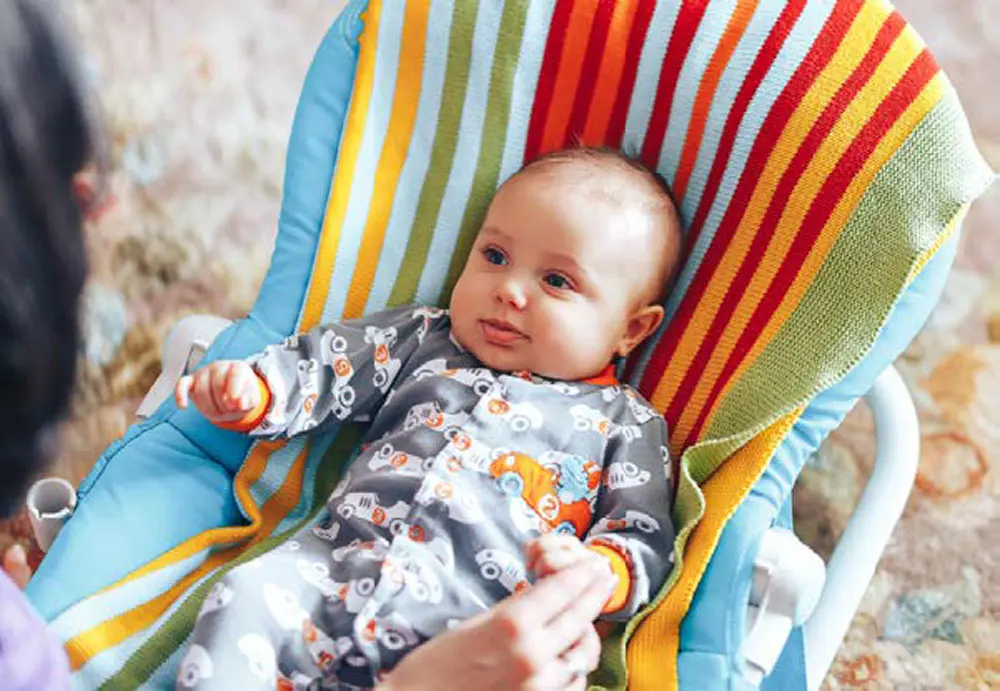NATION — In a major push for infant safety, federal consumer safety regulators are advocating for a comprehensive redesign of baby loungers. This initiative follows a series of alarming incidents, including 79 deaths since 2010, linked to the use of these products. The U.S. Consumer Product Safety Commission (CPSC) has taken a definitive stance, calling for changes that will significantly alter the design and functionality of baby loungers to enhance their safety.
The CPSC’s proposed redesigns focus primarily on ensuring that all lounger surfaces are sufficiently firm. This redesign aims to prevent the loungers from conforming to a baby’s face, thereby reducing the risk of suffocation. Another significant recommendation is to limit the height of the infant support side cushions to no more than two inches. This measure seeks to reduce the dangers of entrapment and suffocation and to dispel any misconceptions that these products are safe for unattended infants.
Alex Hoehn-Saric, the Chair of the CPSC, highlighted the urgent need for these measures. He pointed out the absence of both voluntary and mandatory safety standards for infant support cushions, stressing the real risks posed by these products. Hoehn-Saric emphasized the tragedy of families losing children in products they believed to be safe, underscoring the CPSC’s commitment to establishing a safety standard that would prevent such heartbreaking incidents.
In its investigation into the safety of baby loungers, the CPSC identified at least 79 reported deaths from 2010 to 2022 that involved these products. Furthermore, they noted an additional 125 non-fatal incidents or reports involving loungers during the same period. Notably, over 80% of these deaths involved infants aged three months and younger. The majority of these fatalities were attributed to asphyxia or probable asphyxia, occurring when infants were placed on loungers in or on adult beds, futons, cribs, bassinets, play yards, or couches.
One of the most notable incidents involved the recall of over 3 million Boppy Newborn Loungers in 2021. This recall was issued after eight infants died as a result of using the product between December 2015 and June 2020. Despite the recall, two more infant deaths were reported following its announcement, prompting the CPSC to issue a renewed warning against using Boppy Newborn Loungers.
In another concerning development, the CPSC recently recalled more than 4,000 Yoocaa baby loungers sold on Amazon due to suffocation risks. This action underscores the CPSC’s ongoing efforts to ensure that baby products on the market adhere to strict safety standards. The CPSC continues to stress the importance of providing infants with a safe sleeping environment. They recommend that infants sleep on a firm, flat surface in a crib, bassinet, or play yard, and caution against the use of blankets, pillows, padded crib bumpers, or other items in an infant’s sleeping area.
The CPSC’s actions represent a significant step in addressing the safety concerns associated with baby loungers. As the regulatory body continues to evaluate and implement necessary changes, the safety of the youngest and most vulnerable members of society remains a top priority. The proposed redesigns and recalls are critical in preventing further tragedies and ensuring that baby products on the market are as safe as possible for infants.
The push for reform in infant lounger safety extends beyond redesigns and recalls. Recent actions by the CPSC against specific products highlight the broader regulatory challenges in this sector. A case in point is the warning issued against La-La-Me infant loungers, which were found non-compliant with mandatory federal safety standards for infant sleep products. The CPSC identified multiple safety shortcomings, including inadequate side height, fabric-sided openings, and insufficient labeling and instructional literature. The failure to meet these standards poses both suffocation risks and fall hazards for infants.
La-La-Me, a New York-based seller, faced scrutiny for its Organic Newborn Loungers, which were available in various fabrics and colors. Despite the evident safety concerns, La-La-Me has not agreed to a recall, leading the CPSC to advise consumers to immediately stop using the product, cut the fabric, and dispose of the loungers. This situation underscores the CPSC’s broader mandate to enforce compliance with infant sleep product safety rules, even for products manufactured before the implementation of stricter regulations in June 2022.
An investigative report by NBC News has brought additional concerns to light, revealing that the number of infant deaths linked to loungers may be significantly higher than previously reported. The analysis, which included autopsy reports, lawsuits, and CPSC data, found at least 26 baby deaths between 2015 and 2023 associated with various brands of infant loungers. This figure is more than double the deaths initially cited by the CPSC in its warnings. These findings have raised questions about the accuracy of reporting and the need for more stringent oversight.
The report highlighted that most deaths occurred when infants, placed in the loungers while awake, quickly fell asleep and suffocated against the soft fabric. This has drawn attention to the marketing of infant loungers, which are often advertised as safe for use only with awake babies, thus avoiding the stricter CPSC oversight that applies to infant sleep products. However, the reality that infants can unexpectedly fall asleep in these products has led to tragic consequences.
In the wake of these revelations, CPSC staff members advocated for tighter regulations and recalls of similar infant lounger products. They requested that the agency compel manufacturers to either redesign their products or cease selling them. Despite these efforts, CPSC commissioners reportedly rejected the proposal for stricter regulation, and an annual operating plan was approved that removed the proposal for tighter regulation of infant loungers and pillows.
Subsequent to this decision, at least five additional infant deaths linked to suffocation in loungers were reported. Although a CPSC-commissioned study in 2022 confirmed the elevated risk of suffocation deaths associated with infant loungers, the agency has yet to issue broad warnings about their use. This inaction is partly attributed to federal laws requiring the CPSC to consult with individual product manufacturers before publicly announcing potential safety hazards.
As 2023 unfolds, the CPSC’s operating plan includes comprehensive federal guidelines for infant loungers and pillows. However, the development of these new rules is expected to take until at least the end of the year. This timeline highlights the complexities and challenges involved in establishing and enforcing safety standards in a rapidly evolving and highly diverse market.
The issue of infant lounger safety has reached a critical juncture, with federal regulators grappling to enforce and update safety standards. The challenges highlighted in the previous parts of this series underscore the complexity of regulating a diverse and rapidly evolving market. As the Consumer Product Safety Commission (CPSC) works towards implementing comprehensive guidelines by the end of 2023, the urgency of addressing these risks remains paramount.
The widespread use of infant loungers, coupled with the alarming number of related fatalities, has sparked a national conversation on the safety of baby products. The findings from various investigations, including those by NBC News, reveal a concerning discrepancy in the reported number of deaths, suggesting that the actual figures may be significantly higher. This discrepancy raises serious questions about the efficacy of current reporting and monitoring systems in capturing the true extent of the risks associated with these products.
The CPSC’s response, while proactive in certain respects, has also been critiqued for its pace and scope. The rejection of proposals for tighter regulations on infant loungers and pillows by CPSC commissioners, and the subsequent deaths that occurred thereafter, point to a need for more decisive action. This situation is further complicated by legal requirements that mandate consultation with manufacturers before public disclosure of potential hazards, potentially delaying critical safety warnings.
For Mohave County residents, these developments are a stark reminder of the importance of vigilance when it comes to infant safety. The CPSC’s recommendations for safe infant sleeping practices – using a firm, flat surface without added bedding materials and always placing infants on their backs to sleep – are essential guidelines for caregivers. Local healthcare providers and child safety advocates are echoing these recommendations and urging parents to stay informed about the latest safety standards and product recalls.
As the CPSC continues to navigate the regulatory landscape, the prioritization of infant safety remains a key concern. The agency’s efforts to enhance safety standards for baby loungers are a step in the right direction, but the path to ensuring the well-being of the nation’s youngest citizens is ongoing. The story of infant lounger safety is a potent reminder of the delicate balance between product innovation, regulatory oversight, and the paramount importance of protecting vulnerable lives.
— Jeremy Webb
Lake Havasu Annual Holiday Boat Parade of Lights returns for 2024
LAKE HAVASU — Lake Havasu City, Arizona, will once again come alive with holiday spirit on...
Read More

























